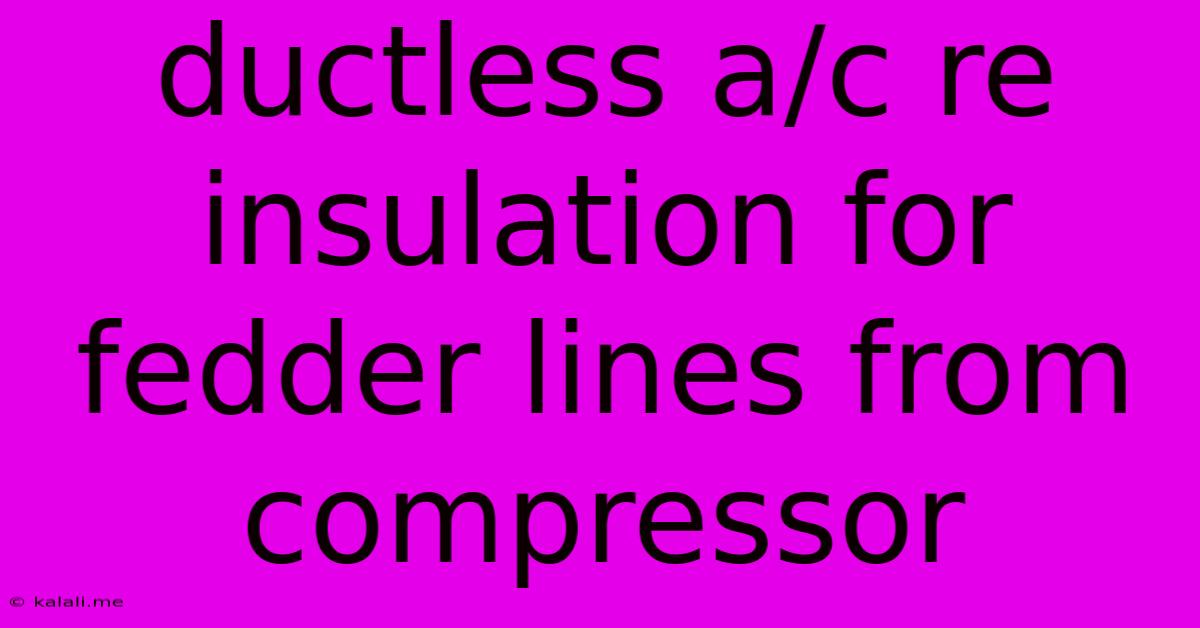Ductless A/c Re Insulation For Fedder Lines From Compressor
Kalali
May 23, 2025 · 3 min read

Table of Contents
Ductless A/C Re-Insulation: Protecting Your Fedder Lines from Compressor
Ductless mini-split air conditioning systems offer efficient climate control, but their exposed refrigerant lines—often called "fedder lines"—can significantly impact their performance and energy efficiency. These lines, connecting the indoor and outdoor units, are susceptible to heat gain or loss, leading to reduced cooling capacity, increased energy consumption, and potential system malfunctions. This article details the importance of proper insulation for your ductless A/C fedder lines, especially those emanating from the compressor, and how to effectively re-insulate them to optimize system performance.
Why Insulate Your Fedder Lines?
Proper insulation for your refrigerant lines is crucial for several reasons:
-
Improved Efficiency: Heat transfer between the refrigerant lines and the surrounding air impacts the system's efficiency. Insulation minimizes this heat exchange, allowing the refrigerant to maintain its optimal temperature for efficient cooling. This translates to lower energy bills and a smaller carbon footprint.
-
Increased Cooling Capacity: By preventing heat gain, insulation ensures the refrigerant reaches the indoor unit at the desired temperature, maximizing the system's cooling capacity. This is especially important during peak demand periods.
-
Enhanced System Lifespan: Fluctuations in refrigerant temperature due to inadequate insulation can strain the compressor and other system components, potentially shortening the overall lifespan of your ductless AC.
-
Reduced Condensation: Proper insulation prevents condensation on the refrigerant lines, which can lead to water damage and potential mold growth.
-
Quieter Operation: Insulation can help dampen vibrations and noise emanating from the refrigerant lines, contributing to a quieter overall operation of your system.
Identifying Insufficient Insulation and Damage
Before re-insulation, assess the existing insulation. Signs of inadequate or damaged insulation include:
- Visible gaps or tears in the existing insulation.
- Degraded or brittle insulation material.
- Moisture or condensation buildup on the refrigerant lines.
- Notably higher energy bills than expected.
- Reduced cooling performance.
Materials and Techniques for Re-Insulation
Several materials are suitable for insulating ductless A/C fedder lines, each with its own advantages:
-
Armaflex: A closed-cell polyethylene foam insulation known for its flexibility, durability, and excellent thermal performance. It's easy to apply and available in various thicknesses.
-
Foam Pipe Insulation: Comes in pre-slit sleeves that simply slide onto the lines. This is a quick and straightforward method for insulating smaller diameter lines.
-
Fiberglass Insulation: While less commonly used for refrigerant lines due to its susceptibility to moisture, it can be effective if properly protected with a vapor barrier.
The Re-Insulation Process:
-
Safety First: Always disconnect the power to your ductless AC system before starting any insulation work.
-
Measure and Cut: Carefully measure the length of the lines requiring insulation and cut the insulation material to the appropriate size, allowing for overlap.
-
Apply the Insulation: Carefully slide the insulation onto the refrigerant lines, ensuring a snug and complete fit. Overlap the edges to prevent gaps. Secure the insulation with suitable tape or adhesive, particularly around connections and joints to prevent air infiltration.
-
Protecting the Insulation: Consider adding a protective outer layer, especially in harsh weather conditions, to further enhance the longevity and performance of the insulation.
-
Restore Power: Once the insulation is complete, carefully restore power to your ductless AC system and monitor its performance.
Choosing the Right Insulation Thickness: The appropriate thickness of insulation depends on various factors including climate, line diameter, and desired performance improvement. Consult a qualified HVAC professional for recommendations tailored to your specific system and environment.
By investing time and effort in properly insulating your ductless A/C fedder lines, particularly those connected to the compressor, you significantly enhance the efficiency, longevity, and overall performance of your system. While DIY is possible, consulting a qualified HVAC technician for complex installations or significant damage is always recommended to ensure proper installation and system safety. Remember, proper insulation is a cost-effective way to improve comfort and reduce energy costs in the long run.
Latest Posts
Latest Posts
-
How Long Can You Store Gas In A Can
May 23, 2025
-
Grab An Image Thats Outside Display
May 23, 2025
-
Blender Weird Face Showing Up When Not In Edit Mode
May 23, 2025
-
How Long Is A 1 Hour Walk Through A Jungle
May 23, 2025
-
What Are Books And Movies Considered
May 23, 2025
Related Post
Thank you for visiting our website which covers about Ductless A/c Re Insulation For Fedder Lines From Compressor . We hope the information provided has been useful to you. Feel free to contact us if you have any questions or need further assistance. See you next time and don't miss to bookmark.